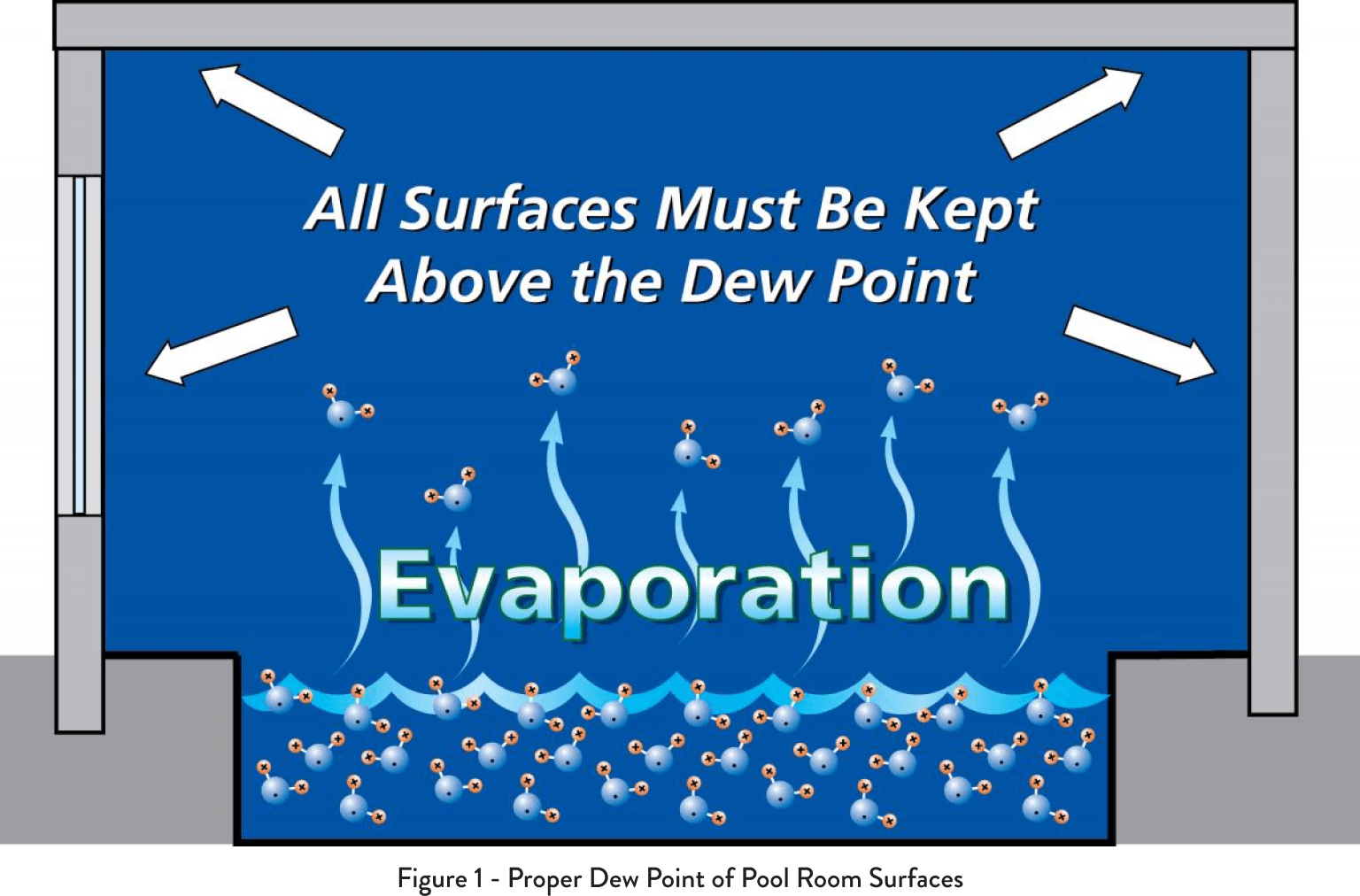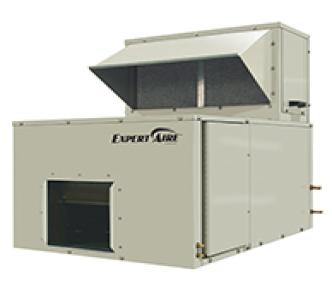
Swimming Pool Dehumidifier Sizing | AN10
This application note highlights the source of moisture loads in pool room enclosures and its potential harmful effects if left uncontrolled.
Gated Content Overview Headline
Lorem ipsum dolor sit amet, consectetur adipiscing elit, sed do eiusmod tempor incididunt ut labore et dolore magna aliqua.
Ut enim ad minim veniam, quis nostrud exercitation ullamco laboris nisi ut aliquip ex ea commodo consequat. Duis aute irure dolor in reprehenderit in voluptate velit esse cillum dolore eu fugiat nulla pariatur. Excepteur sint occaecat cupidatat non proident, sunt in culpa qui officia deserunt mollit anim id est laborum.
Gated Content
Please fill out the form for access.
Sources Of Moisture Load
Indoor pools have three main sources of moisture:
- Evaporation from pool water surfaces
- Outdoor ventilation air
- People
The vapor pressure difference between pool water and the air causes continuous evaporation. The vapor pressure of both water and air will change based upon each one’s temperature and the differences in their temperatures. The evaporation rate increases the higher the water temperature is in relationship to the air temperature. The activity level at the water surface will also either increase or decrease the evaporation rate. Activity factors as defined by the ASHRAE Applications Handbook are shown in Table 2 of this bulletin.
During the summer months, outdoor ventilation air that is being introduced into the space to meet local code requirements may also be contributing to the moisture load of the space depending on the climate location.
The presence of spectators also adds to the moisture load of the space. This load is typically minimal in residential pools but can be fairly substantial when bleacher spectator areas are present.
Problems with Humidity
Air is a gas. Like most gases, it expands in volume when heated and contracts in volume when cooled. This expansion or contraction that occurs with changing temperatures increases or decreases the percentage of moisture that the air can hold. In other words, as air expands, its ability to hold moisture increases. For a given moisture content, the percentage of moisture to air volume (relative humidity) is reduced when air is heated.
Condensation
Condensation is one of the major enemies to an indoor pool environment. When condensation develops on surfaces, it can damage the material it forms on and also provides food for fungi and bacteria to grow.
Visible condensation will appear when the surface temperature is below the indoor dew point of the space. (See Figure 1.) In most pool environments, this dew point is in the range of 58° F to 66° F. The surface temperature can be calculated using the formula:
Ts = Ti – (K x (1/R) x (Ti – To))
Ts = Surface Temperature
Ti = Indoor Temperature
K = Constant of 0.68 for Vertical Surface
R = R Value of Structural Panel
To = Outdoor Temperature
Since windows are the major contributor to condensation in this environment, we will only look at this building component. However, the same process can be used for any building component. Windows typically do not have an R value but are rated with U values. The U value is the reciprocal of the R value, R = 1/U.
The U values published for windows are for the entire window assembly and do not reflect the U value for each component of the window. For this reason we recommend that you add 5° F to the actual calculated surface temperature and use this value for your dew point. This would mean that all surfaces in an indoor pool environment should be kept above 63° F to 71° F to prevent visible condensation.
If you’re more comfortable referencing percent relative humidity, Graph’s 1, 2 and 3 show what percent relative humidity that surface condensation will appear for different U values at indoor space temperatures of 76° F, 82° F and 86° F with outdoor temperatures of 25° F, 0° F, and -25° F.

Humidity Range
The American Society of Heating Refrigeration and Air Conditioning Engineers (ASHRAE) recommends that you maintain between 50% and 60% relative humidity in an indoor pool environment. Relative humidity above 60% will be uncomfortable to the occupants of the space, promotes the growth of certain fungi and bacteria and makes it more difficult to prevent visible condensation. A relative humidity below 50% will cause evaporative cooling on swimmers’ skin as they exit the water, giving them a chilling effect. Lower humidity levels will also cause more water evaporation, requiring more make-up water and more chemical usage, therefore requiring larger equipment and an increase in operating costs.

Methods of Humidity Control
Several different techniques can be used to reduce humidity in an indoor pool environment. One of the oldest and most common practices in years past was to use a make-up air / exhaust method. Warm moist air is exhausted to the outdoors and new outdoor air is introduced into the building. (See Figure 2.) During the winter months, this air needs to be heated to the room temperature before entering the space. A high operating cost is associated with this process. During the spring, summer and fall in certain parts of the country, the outdoor air actually may have more moisture in it than the indoor environment. This will cause the indoor humidity to rise and potentially cause building damage.

In some parts of the country, the outdoor air may be drier than the indoor environment. At first glance, it appears that this solves all humidity problems. As long as the indoor humidity is below 60% RH, there shouldn’t be a problem. However, considering today’s high energy costs, we also must add operating costs into the equation. If we take a 75 foot by 25 foot pool that has an average depth of 6 feet, we find that this contains 84,000 gallons of water. Let’s assume that the space is maintained using outdoor air and we are in a dry climate, say constantly below 30% relative humidity.
This pool is evaporating 85.3 pounds of moisture per hour or 10.3 gallons per hour. This means in 340 days the pool is empty. If we maintain 50% relative humidity in the space, the evaporation rate decreases to 52 lbs/hr or 6.24 gallons per hour. In the same 340 days, we have saved the cost of over 50,000 gallons of make-up water. Also associated with this savings is the energy to reheat this water and the chemical costs to treat it. We have reduced the makeup water and chemical costs by about 40%.
The most effective method of maintaining appropriate relative humidity levels and achieving these types of savings is to use a refrigerationbased dehumidification system. (See Figure 3.)

Calculation Of Moisture Load
Table 1 provides ASHRAE’s recommended design temperatures for indoor pools. The table indicates a maximum of 90° F air temperature (Elderly Swimmers). While not shown in the table, ASHRAE also suggests that the air temperature should not exceed 86° F which would be above the comfort threshold. Also, most refrigeration circuits are only designed for a maximum of 90° F.

Discussion of the evaporation formula is beyond the scope of this application note. Desert Aire uses the latest information from the ASHRAE Applications Handbook. ASHRAE’s formula uses the vapor differential method of determining the evaporation rate from the water surface. This formula is used to develop the factors listed in Table 1. The values listed in Table 3 are based on 25 FPM of air movement across the surface of the water. Variations of this formula are available to account for an increase in air movement over the water surface.
All values in Table 3 are based on an activity factor of one (1) and are for the occupied times of operation. Table 2 lists different activity factors that can be applied to your end results based on the type of pool you are designing.
Please note that all unoccupied hours of operation should apply the activity factor of 0.5 to determine the evaporation rate.


Ventilation Air
The amount of ventilation air required is generally accepted to be the amount as recommended by ASHRAE Standard 62.1. Most codes are based on this method but always check with your local code authority for the proper method of calculating this amount. The 2007 version of this standard recommends that this be based on the square footage of water surface at a rate of 0.48 cfm per square foot, while the square footage of the deck / floor area be calculated at some other rate, generally at 0.06 cfm per square foot. If the space includes a spectator area, which means a place where people can sit and watch, than you must also include 7.5 cfm per person plus 0.06 cfm per square foot of bleacher area.
This standard also suggests that when calculating the moisture of the ventilation air being introduced into the space that you use the ASHRAE Dehumidification Weather Data. Desert Aire recommends using the 1% weather conditions. A selection of cities and values across the United States and Canada are listed in Table 5.
The following formula is used to determine the amount of moisture in the ventilation air:
Moisture in lbs/hr = cfm x Δgrains / 1,555
Δgrains = value from Table 5 – value from Table 4


Human Impact On Moisture
Moisture contributed by people is normally only accounted for when spectator or bleacher areas are part of the space design. Most design manuals will list the latent moisture per person in the values of btu/h. The values these manuals list are usually for indoor conditions below 80° F. Most indoor pools are above 80° F so 20% more latent must be added to the listed values in most design books. Desert Aire recommends a value of 190 btu/h per person. If you had 100 people, this would give you 19,000 btu/h of moisture. To convert this value to lbs/hr of moisture, use a factor of 1,061 btu/h per lb. Therefore, 19,000 btu/h is equal to 17.9 lbs/hr or about the same as the evaporation from a 400 square foot pool surface that is running at 82° F within the space, 80° F water and 55% RH.
Conclusion
Commercial pool enclosures must consider all three humidity load calculations – air, water and people – to determine the total moisture load. A design professional must still perform a sensible heating and cooling load to ensure that the selected equipment can maintain the space temperature during the entire year. This application note is only intended to give you a general understanding of what is involved in the calculation process. Please contact your nearest Desert Aire Representative for assistance with the design of your pool facility and dehumidification system.
Share or Download
Ask A Question
Related Products

ExpertAire Horizontal (LC), Vertical (LV) & Packaged (LCQ) Series Dehumidifier
Designed for high efficiency and long life, Desert Aire’s ExpertAire™ commercial dehumidification ...
View Details

SelectAire™ Series Dehumidifier
The SelectAire™ commercial dehumidification systems are ideal for large-scale moisture removal appli...
View Details

SelectAire Plus™ (SP) Series Dehumidifier
Designed specifically for large 50 meter pool applications, the SelectAire Plus™ Series modular dehu...
View Details

SwimAire™ Series Dehumidifier
With 39 to 112 lbs/hr of moisture removal capacity, 3,000 to 8,500cfm of air handling and 8 to 23 tons...
View Details
Find a Desert Aire Sales Rep Near You!
Our network of independent representatives are fully trained on Desert Aire’s dehumidification and DOAS solutions and can assist you in designing and sizing your engineered solutions.

